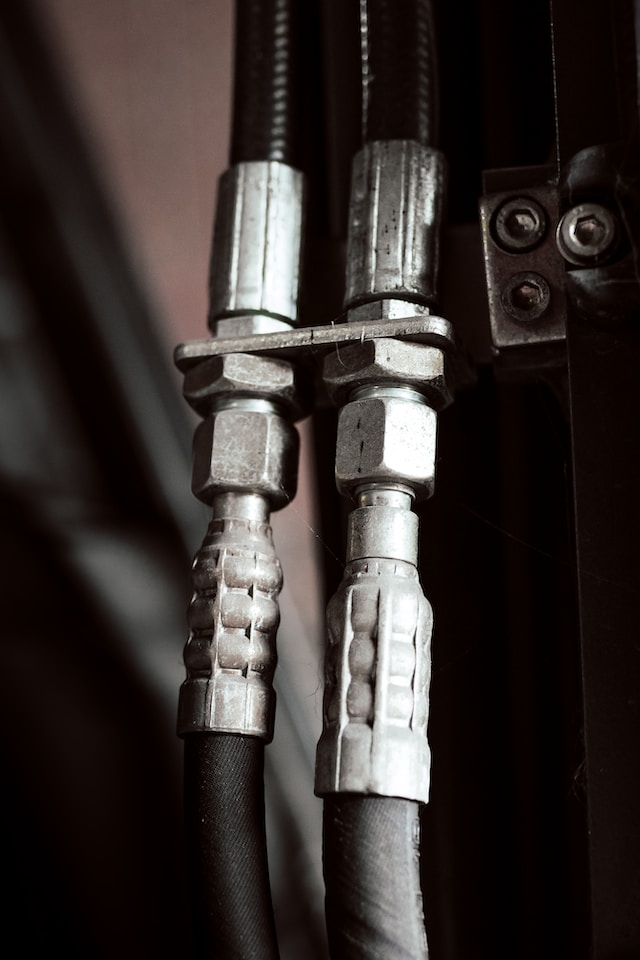Hydraulic hoses can take a beating. They can be damaged by direct damage immediately behind the hose end or general external wear from being dragged over the ground and concrete in cleaning applications.
Whenever a hose needs replacing, the replacement should be matched to the original specification of the equipment. This means knowing the equipment type, working and impulse pressures, and fluid to be conveyed.
Broken Wires
Look for cracks in the cover during a visual inspection of the outer covering of hydraulic or high-pressure hoses. Any cracks or holes expose the reinforcement to the environment, which can degrade over time. Look for snags or tears on the cover, too.
Check the hose for cover blisters, indicating chemical attack, aging, or a lack of proper installation and routing. If you observe a change in color or a decrease in flexibility of the outer layer, it is a sign that internal damage is likely to occur soon. Also, look for a kinked or flattened hose, which can restrict material flow and reduce hose performance.
Contact a professional hydraulic mobile hose repair Charlotte NC if you find any issues. These services come fully equipped with mobile vans with tools, equipment, and parts to repair or replace burst hoses quickly. They are also fully trained to observe and comply with onsite health and safety regulations.
Faulty Fittings
Like all equipment, hydraulic machinery will eventually wear down and require repair. When a hose ruptures, it can bring your entire operation to a screeching halt and cause expensive downtime, production delays, unnecessary cleanup, wasted materials, and inflated labor costs.
Often, a leak occurs because the fitting is not inserted deeply enough into its shell during assembly. It is essential to crimp the shell grips tightly and not leave any gaps. The last grip is especially crucial in developing the full holding strength of the fitting to the hose.
Handling a pressurized hose without the proper precautions is incredibly dangerous. Replacing a hose can be hazardous if hot hydraulic fluid is injected into the skin, resulting in severe injury or death. To prevent further issues, it is crucial to clean the ports in the machine thoroughly before installing the replacement hose to avoid any debris or dirt from falling into it.
Burst Hose
Hydraulic hoses are a crucial component of any piece of equipment. They ensure that machine operations are smooth and efficient. If you have a faulty hose, it can lead to production delays and costly downtime. This can also put workers at risk of physical injury.
The sizing of any hydraulic hose is critical for the system’s success. Too large an inner diameter can cause sluggish performance, while too small an inner diameter can cause the hose to leak or burst. This is why choosing a company with extensive experience in repairing various hydraulic hoses is essential.
A good service should be able to identify the problem and conduct a thorough repair job within the shortest possible time. This way, they can minimize the disruption to your operations and help you fulfill those time-bound contracts. Ideally, they should be able to perform repairs onsite to reduce downtime.
Damaged Cover
A hydraulic mobile hose is subject to natural wear and tear like any other equipment. Your hose breaking is not a matter of if but of when.
Hydraulic hoses are exposed to various environmental conditions that can lead to premature failure, such as sunlight, ozone, and extreme temperatures. These conditions cause abrasion on the cover, expose reinforcement and increase the risk of rust and leakage.
Abrasion damage usually happens at the hose-to-fitting interface, where the hose is crimped or clamped to the couplings. A hose may also be damaged when routed incorrectly or has too tight of a bend radius, increasing stress on the hose. Regular visual inspections are crucial to minimizing the damage to your high-pressure hose assemblies.

